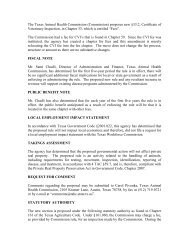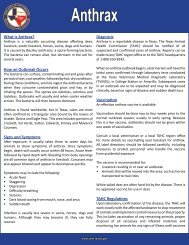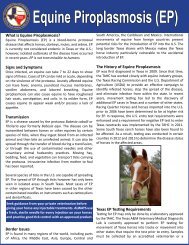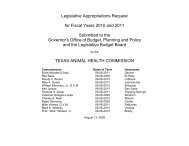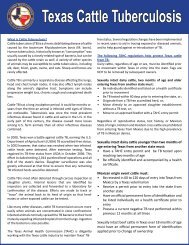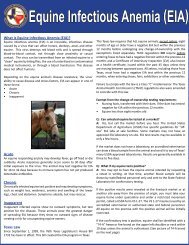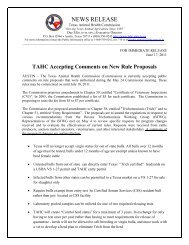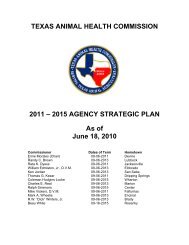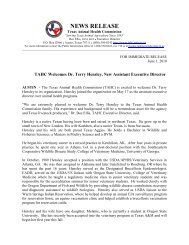(CFT) for Detection of Bovine Tuberculosis (TB) - Texas Animal ...
(CFT) for Detection of Bovine Tuberculosis (TB) - Texas Animal ...
(CFT) for Detection of Bovine Tuberculosis (TB) - Texas Animal ...
Create successful ePaper yourself
Turn your PDF publications into a flip-book with our unique Google optimized e-Paper software.
Caudal Fold Test (<strong>CFT</strong>) <strong>for</strong> <strong>Detection</strong> <strong>of</strong> <strong>Bovine</strong> <strong>Tuberculosis</strong> (<strong>TB</strong>)<br />
Submitted by: Dr. Jody Hall<br />
TAHC Field Epidemiologist<br />
The State-Federal Cooperative <strong>Bovine</strong> <strong>Tuberculosis</strong> (<strong>TB</strong>) Eradication<br />
Program is now in its 96th year, and although the national herd<br />
prevalence has dropped dramatically since the program’s inception,<br />
eradication ef<strong>for</strong>ts have not eliminated the disease from the United<br />
States Many factors contribute to the current situation regarding <strong>Bovine</strong><br />
<strong>TB</strong> in the U.S., and some variation exists depending on US cattle herd<br />
demographics. Although the primary focus <strong>of</strong> <strong>Bovine</strong> <strong>TB</strong> surveillance<br />
moved from live animal testing to slaughter inspection in the early<br />
1960’s, testing <strong>of</strong> animals <strong>for</strong> interstate commerce still remains vital to<br />
eradication ef<strong>for</strong>ts. The purpose <strong>of</strong> this article is to reiterate the factors<br />
involved in using the Caudal Fold Test (<strong>CFT</strong>) <strong>for</strong> detection <strong>of</strong> <strong>Bovine</strong> <strong>TB</strong>.<br />
Since the <strong>CFT</strong> is a presumptive test, it is imperative that tuberculin be handled properly and that<br />
protocol <strong>of</strong> injection and observation be followed as correctly as possible. Because <strong>of</strong> the potential<br />
<strong>for</strong> the presence <strong>of</strong> Mycobacterium avium, Mycobacterium paratuberculosis, and saprophytic<br />
Mycobacterial species, the expected response rate <strong>for</strong> the <strong>CFT</strong> in a normal population ranges from 1 –<br />
5%. This expected false positive rate is based on the historical statistical analysis <strong>of</strong> millions <strong>of</strong><br />
properly per<strong>for</strong>med <strong>CFT</strong> tests. A chart outlining the expected response rate <strong>for</strong> any number <strong>of</strong> cattle<br />
tested can be found on the last page <strong>of</strong> the USDA <strong>Tuberculosis</strong> UM&R.<br />
The <strong>Texas</strong> <strong>Animal</strong> Health Commission (TAHC) routinely monitors response rates <strong>of</strong> accredited<br />
veterinarians in an ef<strong>for</strong>t to increase the overall confidence <strong>of</strong> <strong>TB</strong> testing in <strong>Texas</strong>. Factors that<br />
influence the likelihood <strong>of</strong> a valid response include, but are not limited to:<br />
• Proper intradermal injection <strong>of</strong> tuberculin<br />
• Presence <strong>of</strong> pre-existing skin lesions at injection site<br />
• Interpretation <strong>of</strong> response<br />
• Potency <strong>of</strong> tuberculin<br />
• Proper needle/syringe size<br />
If a bleb at the injection site was not observed, then the injection was most likely subcutaneous and<br />
the result will not be valid. To help ensure a proper intradermal injection is applied, tuberculin should<br />
only be injected using 1cc syringes with a 26 gauge 3/8” intradermal bevel needle. Skin lesions and<br />
swellings present at the injection site prior to injection <strong>of</strong> tuberculin will play a role in accuracy <strong>of</strong><br />
reading the response at time <strong>of</strong> observation, and a different injection site should be chosen in those<br />
cases with notation on the test chart. The <strong>CFT</strong> is not a quantitative test, there<strong>for</strong>e any response at the<br />
injection site, whether a noticeable nodule or simply a slight increase in skin thickness, should be<br />
reported as “suspect”.
Improper handling <strong>of</strong> tuberculin can also result in an invalid test. Since tuberculin denatures from<br />
exposure to light, it should be stored in the dark at 35-45°F. Tuberculin is susceptible to oxidation;<br />
there<strong>for</strong>e any partial opened vials should be discarded within four weeks. Finally, it has been<br />
demonstrated that the potency <strong>of</strong> tuberculin is decreased by as much as 98% when stored in plastic<br />
containers <strong>for</strong> more than 12 hours, there<strong>for</strong>e any unused tuberculin in syringes should be discarded.<br />
All suspect animals disclosed on the caudal fold test reading date should be immediately reported to<br />
the appropriate TAHC regional <strong>of</strong>fice so that follow up testing can be planned. Further evaluation <strong>of</strong> a<br />
suspect on the <strong>CFT</strong> will involve either the Comparative Cervical Test per<strong>for</strong>med a TAHC or USDA<br />
veterinarian within 10 days <strong>of</strong> <strong>CFT</strong> injection, or, more commonly in <strong>Texas</strong> the Bovigam “gamma”<br />
interferon blood test. The TAHC now approves private practitioners to collect blood <strong>for</strong> <strong>TB</strong> gamma<br />
testing. Contact your local TAHC region <strong>of</strong>fice if you are interested in being approved <strong>for</strong> this as the<br />
<strong>TB</strong> gamma test requires special handling and shipping procedures to be effective.<br />
All test results should be recorded on a USDA test chart VS 6-22 including acceptable <strong>for</strong>ms <strong>of</strong> <strong>of</strong>ficial<br />
identification on the cattle and submitted to the appropriate TAHC regional <strong>of</strong>fice as soon as possible.<br />
The proper test chart may be obtained at no charge by contacting the Austin USDA Veterinary Service<br />
<strong>of</strong>fice <strong>for</strong> <strong>Texas</strong> at 512-383-2400.<br />
Recognition <strong>of</strong> the factors involved in a valid <strong>CFT</strong> test and adherence to the principles outlined above<br />
will provide the greatest confidence <strong>for</strong> detecting <strong>TB</strong> in cattle intended <strong>for</strong> interstate commerce.



